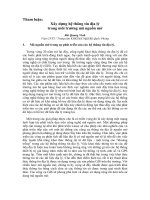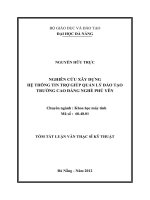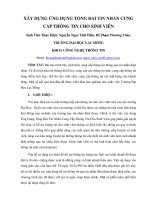The Traditional Approach to Requirements (XÂY DỰNG ỨNG DỤNG HỆ THỐNG THÔNG TIN SLIDE)
Bạn đang xem bản rút gọn của tài liệu. Xem và tải ngay bản đầy đủ của tài liệu tại đây (1.11 MB, 53 trang )
6
Chapter 6:
The Traditional Approach
to Requirements
Systems Analysis and Design in a Changing
World, 3rd Edition
6
Learning Objectives
Explain how the traditional approach and the
object-oriented approach differ when an event
occurs
List the components of a traditional system and
the symbols representing them on a data flow
diagram
Describe how data flow diagrams can show the
system at various levels of abstraction
Systems Analysis and Design in a Changing World, 3rd Edition
2
6
Learning Objectives (continued)
Develop data flow diagrams, data element
definitions, data store definitions, and process
descriptions
Develop tables to show the distribution of
processing and data access across system
locations
Read and interpret Information Engineering
models that can be incorporated within traditional
structured analysis
Systems Analysis and Design in a Changing World, 3rd Edition
3
6
Overview
What the system does what an event occurs:
activities and interactions
Traditional structured approach to representing
activities and interactions
Diagrams and other models of the traditional
approach
RMO customer support system example shows
how each model is related
How traditional and IE approaches and models
can be used together to describe system
Systems Analysis and Design in a Changing World, 3rd Edition
4
Traditional and Object-Oriented Views of
Activities
Systems Analysis and Design in a Changing World, 3rd Edition
6
5
Requirements Models for the Traditional
and OO Approaches
Systems Analysis and Design in a Changing World, 3rd Edition
6
6
6
Data Flow Diagrams
Graphical system model that shows all main
requirements for an IS in one diagram
Inputs / outputs
Processes
Data storage
Easy to read and understand with minimal
training
Systems Analysis and Design in a Changing World, 3rd Edition
7
6
Data Flow Diagram Symbols
Systems Analysis and Design in a Changing World, 3rd Edition
8
6
DFD Fragment from the RMO Case
Systems Analysis and Design in a Changing World, 3rd Edition
9
6
DFD Integrates Event Table and ERD
Systems Analysis and Design in a Changing World, 3rd Edition
10
6
DFD and Levels of Abstraction
Data flow diagrams (DFDs) are decomposed into
additional diagrams to provide multiple levels of
detail
Higher level diagrams provide general views of
system
Lower level diagrams provide detailed views of
system
Differing views are called levels of abstraction
Systems Analysis and Design in a Changing World, 3rd Edition
11
6
Layers of DFD Abstraction
Systems Analysis and Design in a Changing World, 3rd Edition
12
6
Context Diagrams
DFD that summarizes all processing activity
Highest level (most abstract) view of system
Shows system boundaries
System scope is represented by a single process,
external agents, and all data flows into and out of
the system
Systems Analysis and Design in a Changing World, 3rd Edition
13
6
DFD Fragments
Created for each event in the event table
Represents system response to one event within
a single process symbol
Self contained model
Focuses attention on single part of system
Shows only data stores required to respond to
events
Systems Analysis and Design in a Changing World, 3rd Edition
14
DFD Fragments for Course
Registration System
Systems Analysis and Design in a Changing World, 3rd Edition
6
15
6
Event-Partitioned System Model
DFD to model system requirements using single
process for each event in system or subsystem
Decomposition of the context level diagram
Sometimes called diagram 0
Used primarily as a presentation tool
Decomposed into more detailed DFD fragments
Systems Analysis and Design in a Changing World, 3rd Edition
16
6
Combining DFD Fragments
Systems Analysis and Design in a Changing World, 3rd Edition
17
Context Diagram for RMO
Customer Support System
Systems Analysis and Design in a Changing World, 3rd Edition
6
18
6
RMO Subsystems and Events
Systems Analysis and Design in a Changing World, 3rd Edition
19
Context Diagram for RMO
Order-Entry Subsystem
Systems Analysis and Design in a Changing World, 3rd Edition
6
20
DFD Fragments for RMO
Order-Entry System
Systems Analysis and Design in a Changing World, 3rd Edition
6
21
6
Decomposing DFD Fragments
Sometimes DFD fragments need to be explored
in more detail
Broken into subprocesses with additional detail
DFD numbering scheme:
Does not equate to subprocess execution
sequence
It is just a way for analyst to divide up work
Systems Analysis and Design in a Changing World, 3rd Edition
22
6
Physical and Logical DFDs
Logical model
Assumes implementation in perfect technology
Does not tell how system is implemented
Physical model
Describes assumptions about implementation
technology
Developed in last stages of analysis or in early
design
Systems Analysis and Design in a Changing World, 3rd Edition
23
6
Detailed Diagram for Create New Order
Systems Analysis and Design in a Changing World, 3rd Edition
24
6
Physical DFD for scheduling courses
Systems Analysis and Design in a Changing World, 3rd Edition
25







![[Khóa luận]thiết kế và xây dựng hệ thống tín hiệu đèn giao thông nút giao thông lê hồng phong và nguyễn bỉnh khiêm dùng PLC](https://media.store123doc.com/images/document/13/ce/jj/medium_iEXM7MKsu1.jpg)

